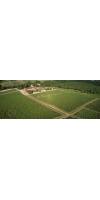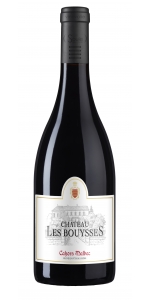Wine from Bouysses

Château Les Bouysses is an ancient priory rich of 800 years of history. It was bought by the Marre Family in 1933. “Bouysses" is the old French word for “buis” – the boxwood that borders the alleys of the property. The 30 hectare-estate is located in the town of Mercues nearby Cahors in the Southwest of France. It is planted with 24 hectares of vines and 6 hectares of walnut trees.
T3: very ancient alluvial deposits - siliceous and gravelly soilT2: ancient alluvial deposits - siliceous, sandy and gravelly soil less altered than T3
The soils are located for 50% on middle terrace (*T2) and 50% on upper terrace (*T3).
A thirteenth century royal decree requesting lords to donate some land to allow the establishment of religious communities and monasteries was at the origin of ‘Les Bouysses’, in 1230. The lord of Rassiels (a place situated above Douelle), Raymond de Lard, therefore ceded land called “Les Bouysses” to Dame Guillemette, the second abbess of Leyme, for the establishment of a cistercian priory. A small number of nuns lived there, perhaps a dozen or thereabouts.
During the Hundred Year- War the nuns were forced to leave by the English. Subsequently the nuns returned until year 1600, from which date they remained at Leyme but kept their eyes on events at the Bouysses priory. In 1745 they authorized the demolition of their chapel which was remplaced by a winery on the same site. Henceforth the wine was located at ‘Les Bouysses’ and the prayers at Leyme.
In 1789 property belonging to the Church became property of the French state and in 1791 the estate was sold to François Agar, who was mayor of Mercuès and wine merchant in Mercuès and Paris-Bercy. A fire at the Bercy warehouse caused his bankruptcy and he was obliged to sell the estate to one of his cousins Count Michel Agar de Mosbourg. The latter built most of the existing buildings with the exception of the winery and one of the cellars. The elegant perron with double flight of stairs outside copy italian designs that he had loved during his trips to Italy. The Orangery was built in 1820. The stables were built nearby following a request by Napoleon Bonaparte who was to have visited with his guard and horses. He never made the journey.
Count Michel Agar de Mosbourg did have one son who had no sons or daughters. It was therefore the nephews of the latter, the Vicomtes de Rougé, who became owners at the end of the nineteenth century. The last viscount, inventor of aircraft tailplanes, sold some land to finance his research. As his invention was stolen before he was able to patent it, and consequently lost the fees he should have received, he was obliged to sell off the rest of the estate.
The Marre family became owners in 1933. Until relatively recently it was a purely agricultural enterprise but it was decided to rehabilitate the main building called the ‘Château’.
Bouysses Cahors is made from 100 percent 100% Malbec.
A beautiful dark brilliant ruby purple color. The nose is complex of black cherry, blackberry with a hint of violet, followed by a buttery and vanilla note. The palate is rich, powerful, with smooth and melted tannins. This wine is fleshy and velvety.
Serve with game meat, red meat, duck confit, and goat cheese.
- back
Selected Options
Wineries
Categories
Pricing
Countries
Regions
Grape Types
Wineries
Organic/Free Shipping
All older vintage wines have been purchased from a single collectors cellar. Pictures can be requested before shipment.
Dominique Piron Morgon Cote du Py is made from 100 percent Gamay.
The Morgon Cru is based in the heart of Northern Beaujolais. Côte du Py is the heart of Morgon, a little hill of very old blue stone rocks - the oldest soils of Beaujolais (around 430 millions years old), with a typical blue color.
Côte du Py has been known for centuries for being the best terroir of the village, producing long lived wines with strong structure and flavors.
Wines of the Côte du Py are very dark, profound and dense. Classic aromas of red berries, cherry, kirsh. Fruity, structured and mineral in the mouth with graphite flavors and spicy notes of black and white pepper. Wine can age up to 10 years.
Hand picked grapes are sorted manually and destemmed for 50 to 70%. Fermentation starts in concrete tanks and lasts for 18-25 days with remontages and pigeages. Then after pressurage starts the aging, for 2/3 in concrete tanks, and 1/3 in recent French oak barrels with batonages on fine lies only. After 10 month we do the blending, keeping only the best cuvees and best barrels, and do the bottling.
Pairs well with red meat like beef, duck and game (Hare, Dear, Wild Pork,…), cheses.





